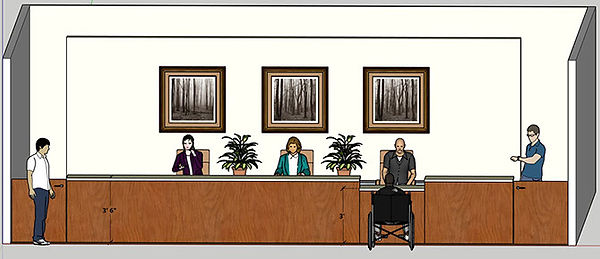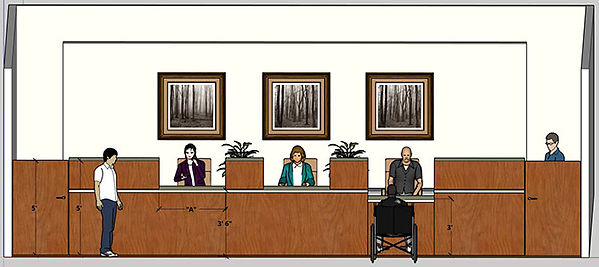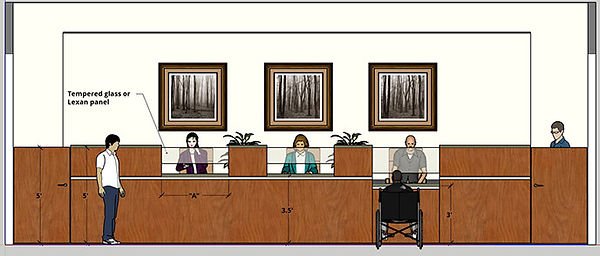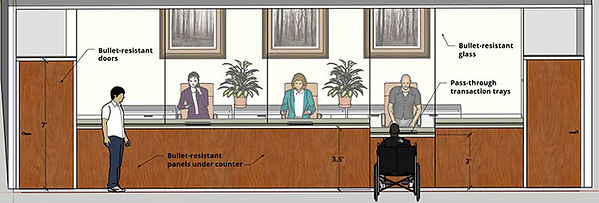Email: info@silvaconsultants.com
Phone: 888.645.2299 (Toll-Free USA)
Design of Service Counters for Good Security
Service counters and reception desks are the place where employees most frequently interact with the public. These can include lobby reception desks, customer service counters, cashier’s stations, information booths, and other similar public contact points. Within this article, we will use the term “service counter” to describe these public contact points, with the understanding that the information given can be equally applied to all similar locations.
Service counters play an important role in a facility’s overall physical security program. In many cases, the employees who work at service counters serve as the first line of defense against intruders entering the facility and often bear the brunt of abuse from angry or disgruntled people.
The way that a service counter is designed can determine how vulnerable the employees at these locations are to physical attack and the degree to which intruders can make their way further into the building. In many cases, service counters have been designed based strictly on operational efficiency or architectural appearance with little or no thought given to security. As a result, many service counters provide only a minimal amount of protection against physical attack.
There is a balancing act between maintaining an open, welcoming environment and providing good physical security. At one end of the spectrum, a completely open facility that offers no physical protection can be provided. This creates a welcoming environment but may place employees and other assets at
risk. At the other end of the spectrum, a highly-secured facility that offers excellent physical protection can be provided. This is good for security but may create an environment that seems unfriendly or unwelcoming.
The point on the security spectrum that any one facility should be at should be based on the level of security risk that the facility faces. Facilities with little or no security risk can generally get by with security measures at the lower end of the spectrum, while facilities with higher security risks generally need to deploy security measures at the higher end of the spectrum. The best way to determine where you should be at on the spectrum is to conduct a thorough Physical Security Assessment.
Four different design concepts for service counter design are presented below, each which provides a different grade of security. While these designs are conceptual in nature, the principles outlined can generally be applied to the service counters at any facility. Please note that it is sometimes appropriate to use different design concepts in different parts of a facility; for example, a cashier’s desk in a public lobby that handles cash could be designed differently from a receptionist’s desk in an interior area of the building.
SECURITY GRADE 1

SECURITY GRADE 2

Description of Security Grade 2
Service counters designed at Security Grade 2 are similar to counters designed at Security Grade 1 except that pillars have been added above the counter-top. These pillars are installed to create defined service windows along the counter. In the drawing above, three service windows are provided. The pillars increase the effective height of the counter at locations other than where there are windows. This limits the locations where an intruder can climb over the counter and provides a psychological barrier that can serve to deter attackers.
The recommended minimum height for the top of the pillar is 5’ above the floor. The width of the service windows (dimension “A” in the drawing above) can vary depending on the grade of security desired. Wider windows (32” to 40”) provide a more open environment, while narrower windows (18” to 24”) provide better protection. The height of the pedestrian doors is increased to match the height of the top of the pillars, typically 5’ above the floor. This makes it much more difficult for an intruder to reach over the door to open it from the inside.
Options
-
Doors can be added at each of the service windows. These doors can be closed and locked when the window is closed or to provide additional protection when a suspicious person is in the lobby.
-
A lever guard can be added to the inside of each door to provide additional protection against a person reaching over the door.
Advantages
-
Provides psychological barrier that can serve to deter attackers.
-
Reduces number of places where an intruder can climb over the counter.
-
Makes it much more difficult for an intruder to reach over a door and open it.
Disadvantages
-
More expensive than Security Grade 1.
-
Slightly less open and welcoming in appearance than Security Grade 1.
-
Not bullet-resistant.
-
Can still be compromised by a motivated intruder.
SECURITY GRADE 3

SECURITY GRADE 4

Description of Security Grade 1
Service counters designed at Security Grade 1 consist of a completely open counter-top design with a typical counter-top height of between 38” and 42”. A lowered section of the counter-top is typically provided for users in wheelchairs. The height of this section is typically 36”. When people must walk behind the service counter from the lobby, one or more half-height pedestrian doors are provided. The height of these doors typically matches the height of the counter-top. A work surface is typically provided along the inside of the service counter. The height of this work surface is typically 30”.
Options
None.
Advantages
-
Lowest cost.
-
Completely open environment is maintained – friendly and welcoming.
-
Plenty of space on counter-top for users to spread out and work with documents.
-
Easy to pass items across counter-top.
Disadvantages
-
Provides minimal protection for employees working at counter.
-
Easy for an intruder to climb over counter or physically attack employee.
-
Easy for an intruder to reach over half-height door and open it from inside.
-
Not bullet-resistant.
Description of Security Grade 3
Service counters designed at Security Grade 3 are identical to counters designed at Security Grade 2 except that tempered glass or Lexan panels would be installed at each service window. These panels would provide employees with increased protection against physical attack and make it more difficult for intruders to climb over the counter.
Options
-
Same as for Security Grade 2.
Advantages
-
Same as for Security Grade 2.
-
Provides increased protection against physical attack.
-
More difficult for intruders to climb over counter.
Disadvantages
-
More expensive than Security Grade 1 or Security Grade 2.
-
Less open and welcoming in appearance than Security Grade 1 or Security Grade 2.
-
Not bullet-resistant.
-
Can still be compromised by a motivated intruder.
-
Slightly more difficult to pass items over counter.
Description of Security Grade 4
Service counters designed at Security Grade 4 are constructed using bullet-resistant materials and provide the highest grade of protection. A traditional counter design similar that described for Security Grade 1 is used, but bullet-resistant glazing is installed above the counter-top, and bullet-resistant wall panels are installed below the counter-top. In most cases, the bullet-resistant glazing extends all the way to the ceiling, creating a solid barrier wall at the lobby. Full-height doors constructed of bullet-resistant materials are used to provide access behind the counter.
Pass-through transaction trays (often called deal trays) are provided at each service counter to permit the passage of documents, currency, and other small items. These trays are specifically designed to be used with bullet-resistant glazing and are available in a variety of different widths.
The bullet-resistant glazing, wall panels, and doors should all be rated to provide the same level of ballistic protection. Suggested minimum level of protection is UL Level 2. (See Introduction to Bullet-Resistant Materials.)
Options
-
Pass-through compartments to allow passage of larger items through counter.
-
Intercom system to improve communications though service windows.
Advantages
-
Provides best protection against intrusion and physical attack.
-
Bullet-resistant.
-
May serve as deterrent against robbery and other types of crimes.
Disadvantages
-
High cost option.
-
May present image to the public that is unwelcoming.
-
Limited ability to pass larger items across the counter. (Unless special pass-through compartments are provided.)
-
New barrier wall may require that changes be made to heating, cooling and fire protection systems.
If you have questions about the information in this article or need help in designing an effective service counter for your facility, please contact us.
Also see related article: Designing Lobbies for Good Security
Like this article?
Visit our Security Tips page for more than 80 additional articles on a variety of topics related to physical security.
Use the button below to subscribe to be notified when a new Security Tip is published.
Did You Know?
Silva Consultants is an independent security consulting firm and does not sell security equipment or products
Need Help?
Silva Consultants can assist you in the design and planning of an effective security program and in the selection of security products and services
Please contact us for further assistance
Want to become an independent security consultant yourself?
New Second Edition now available on Amazon

